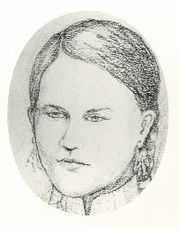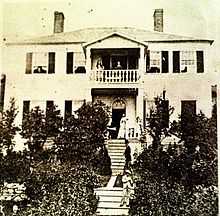Magdelaine Laframboise
| Madeline La Framboise | |
|---|---|
 Artist's depiction from descriptions | |
| Born |
February 1780 Fort St. Joseph, Michigan |
| Died |
April 4, 1846 Mackinac Island |
| Occupation | Fur trader |
Madeline La Framboise (1780–1846), of mixed French and Native American descent, was one of the most successful fur traders in the Northwest Territory. Fur trading was one of the most difficult and dangerous occupations of the time according to historical accounts.[1] She conducted business in the territory that later became the state of Michigan. Due to her success, she was one of the most prominent early businesswomen of Michigan.
Early life
La Framboise was born in February 1781 at Mackinac Island, Michigan after her parents were removed from St. Joseph by the British.[2] Her father was Jean Baptiste Marcotte (1720–1783), a French fur trader. Her mother was Marie Nekesh (circa.1740 - circa. 1790), an Odawa. La Framboise was baptized August 1, 1786, on Mackinac Island. She was raised in a Lac Courtes Oreilles[3] village at the mouth of the Grand River near Grand Haven, Michigan.[4]
She married Joseph La Framboise (1765–1806) in 1794. On September 24, 1795, they had their first child, a daughter, Josette La Framboise (1795–1820).Then in March 1805 they had a son, Joseph La Framboise (1805–1856). Although they considered themselves married already, Madeline and Joseph had their marriage solemnized on July 11, 1804, by a Catholic priest on Mackinac Island.[4]
Fur trading
Madeline La Framboise and her husband Joseph owned many trading posts in west Michigan. Every fall they would travel with their merchandise to trade with the Ottawa Native Americans from Mackinac Island down to the Grand River area to what is now known as Ada, Michigan, where they built another trading post. It was the first permanent mercantile building in the west Michigan area. Every spring they would return to Mackinac Island with the furs they traded for.[5][6]
On her own
Madeline La Framboise took over the trading business after her husband was murdered in 1806. She continued to manage several trading posts, and expanded her business throughout the western and northern portions of Michigan's lower peninsula, while raising two children on her own.
In a time when an experienced fur trader earned about $1000 per year (which was a large sum at the time), La Framboise was earning $5000 to $10000 per year.[7]
- La Framboise, the half-Ottawa wife of a murdered French trapper, owned a string of trading posts in the Grand River Valley. Reputed to be no ordinary woman — probably for succeeding in an exclusively male trade in the "pays d'en haut" or savage country.[8]
- She was acknowledged by the fur trade society, agents as well as Indians, as an intelligent worker in the trade, who was always fair in her dealings.[1]
La Framboise spoke four languages fluently; French, English, Ottawa, and Chippewa, but could not read or write in any language. Although confronted with strong competition from John Jacob Astor's American Fur Company monopoly, La Framboise ran a very successful business until 1818, when the American Fur Company convinced her to merge or sell out (accounts differ). Rix Robinson, another Michigan pioneer consummated the transaction and took over her business.[8] La Framboise, then 41 years old and a very wealthy woman, retired to a stately home on Mackinac Island.
Life on Mackinac Island

After her retirement from fur trading, La Framboise taught herself to read and write French and English. She supported the first school for Native American children on the island. She became a Sunday school teacher at St. Anne's Church. Her devotion to her church and to the education of children secured her place in Mackinac society.[1] She was very active in St. Anne's church and the parish register lists her as godmother for many baptisms and witness at many marriages. When the church leaders decided to move the church from its original location, La Framboise donated the property next to her home as the new site. St. Anne's Church still stands there today.[7][9] In exchange for her gift of land, La Framboise asked to be buried beneath the altar of St. Anne's at the end of her life.
Death and legacy
Madeline La Framboise died April 4, 1846. Father Henri Van Renterghem honored her request and she was buried beneath the altar at St. Annes Church on Mackinac Island, where she still rests today.[10] Her house, next door to the church, still stands, and is now the Harbor View Inn.[11]
Her daughter, Josette La Framboise, was married on April 2, 1816, to Benjamin Kendrick Pierce (1790–1850) the brother of U.S. President Franklin Pierce. Josette had two children. She died November 4, 1820, and is buried in St Anne's churchyard on Mackinac Island.[12]
Her son, Joseph La Framboise, became a fur trader and lived most of his life along the Minnesota River Valley. He married Magdeleine “Sleepy Eyes” Sisseton around 1827. She was a member of the Sioux tribe. They had one son, Francis La Framboise. Joseph's second wife was the daughter of fur trader William Dickson, Jane. Joseph died November 9, 1856, in Nicollet County, Minnesota.[13]
- At her death in 1846, her remarkable achievements in the fur trade were surpassed by her efforts to educate the young. This woman of very humble beginnings left a powerful legacy in the young people she had influenced.[1]
References
- ↑ 1.0 1.1 1.2 1.3 From the Greater Grand Rapids Women's History Council site La Framboise page
- ↑ Mackinac Archives
- ↑ Note: the "Nation of Courte Oreilles" was a tribe of the Odawa
- ↑ 4.0 4.1 from - entry 3298 of rootsweb.com entry for La Framboise accessed December 20, 2006
- ↑ from the Grand Rapids History site accessed December 21, 2006
- ↑ from the Michigan Women's Historical site accessed December 22, 2006
- ↑ 7.0 7.1 from the Grand Rapids Public Library — Making a Difference Exhibit collection 264 description, accessed December 20, 2006
- ↑ 8.0 8.1 A Snug Little Place Memories of Ada Michigan 1821 - 1930, Ada Historical Society/Jane Siegel, 1993, (Siegel 1993) p.23
- ↑ from the St. Annes site accessed December 22, 2006
- ↑ Note: her last will and testament can be found here at rootsweb.com, accessed December 18, 2006
- ↑ The Harbour View Inn website may have more information
- ↑ from rootsweb.com Gentner family tree subsection 3299, accessed December 22, 2006
- ↑ from rootsweb.com Gentner family tree subsection 3554, accessed December 22, 2006
External links
- http://memory.loc.gov/cgi-bin/query/r?ammem/lhbumbib:@field(NUMBER+@band(lhbum+7689a)) LoC American Memories - on their own account - Hist Soc of WI - this account conflicts with other sources.
- http://www.rootsweb.com/~micheboy/church/stanne/baptsa7.html - Baptismal records of Mackinac Island
| ||||||||||||||||||||||||||||||||||||||||||||||||||||||||||||||||||||||||||||||||||||||||||||||||||||||||||||||||||||||||